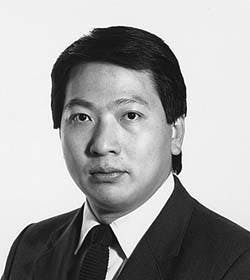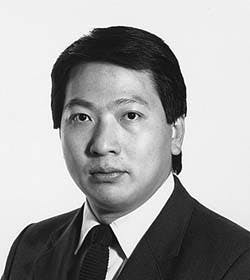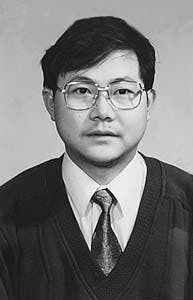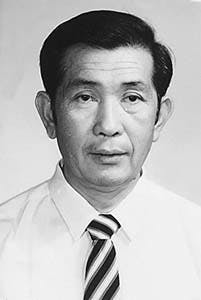Supercritical fluid extraction reveals resid properties
Keng H. ChungThe ability to process bottom-of-the-barrel fractions is strongly dependent on the chemistry of the feedstocks.
Syncrude Canada Ltd.
Edmonton, Alta.Chunming Xu, Yunxiang Hu, Renan Wang
Petroleum University
Changping, Beijing
But, because of the complexity of residue species, there is no standard analytical tool or data base that predicts bottom-of-the-barrel processibility.
This article describes the use of a new tool, supercritical fluid extraction (SCFE), to prepare narrow, deep cuts of residua. The characterization of these narrow cuts provides new insights into the chemistry of the residue fraction.
Why cut deeper?
The supply of light crudes has diminished in recent years. Refiners have therefore been forced to deal with heavier crudes as an inexpensive substitute. One fraction greatly affected by this change is the petroleum residue that is produced from the straight-run distillation of crude oil or heavy oil.
To optimize yields, refiners are cutting deeper into the bottom of the barrel to produce more high-value vacuum gas oil.1 In Syncrude Canada Ltd.'s operations, the feedstock, in the form of bitumen, is derived from Athabasca oil sands. As much as 50% of the bitumen from this crude consists of the residua, so it is even more critical to cut deep into the bottom of the barrel to increase yield.
An additional challenge facing the refining industry is how to deal with the bottom of the barrel under more stringent environmental constraints. The residue fraction of crude oil contains high concentrations of metals and asphaltenes, and cannot be upgraded easily.
Of the viable, commercial residue-upgrading processes, catalytic hydroprocessing has been the technology of choice to convert the residua to lower-boiling products without leaving behind coke as solid waste. But these hydroprocessing catalysts deactivate quickly.2 As a result, the economics of residue hydroprocessing are less attractive than expected.
Cutting deep into the residua will allow for a better understanding of the chemistry of the feedstock. This knowledge, in turn, will allow for fine-tuning of existing residue processes or development of new ones.
Fractionation methods
A number of methods are available for fractionating heavy petroleum feedstock.3
Conventional vacuum distillation is capable of topping distillates up to temperatures as high as 524° C. The use of high-vacuum, short-path distillation has allowed the cut point to be extended to 700° C.
For nondistillable residue fractions, sequential extraction fractionation (SEF) is used to prepare subfractions based on the solubility of residua in various solvents.1 Alternatively, the residua can be separated by gel permeation chromatography (GPC).4 5
These methods are capable of separating nondistillable residua, but they also are tedious and produce only small amounts of sample. These sample volumes are adequate for limited characterization studies, but not for reactivity and conversion studies.
SCFE
Over the past 10 years, supercritical fluid extraction has been successfully developed by the State Key Laboratory of Heavy Oil Processing at the Petroleum University, Beijing. The State Key Laboratory uses SCFE to separate petroleum residua into as many as 20 narrow subfractions, depending on the molecular weight of the fraction.6 7
SCFE operation is similar to conventional vacuum distillation, as shown in Table 1 [6039 bytes]. The advantage of SCFE is that it operates at a temperature much lower than the cracking temperature of the feedstock. SCFE also is capable of producing volumes of each fraction large enough for complete characterization and process scale studies.
A recent characterization study of Chinese petroleum residua showed that the hydrocarbon type and heteroatoms (sulfur, nitrogen, and metals) in the narrow residue fractions varied with the source of feedstock.8 This study showed that the characterization data for the narrow residue fractions are useful for optimizing the operation of vacuum columns, which prepare feedstocks for catalytic cracking units.
Bitumen "subfractions"
Feed for the Syncrude study was atmospherically topped Athabasca bitumen. This stream, comprising heavy gas oil and pitch, is usually used as coker feed in the Syncrude plant. The properties of Athabasca bitumen are listed in Table 2 [6182 bytes].
Narrow fractions of heavy gas oil were prepared from the bitumen by vacuum distillation. The remaining bitumen residue (524+° C. material) was further separated into 10 narrow fractions using the SCFE unit at the State Key Laboratory.
The schematic diagram of the SCFE unit is shown in Fig. 1 [31529 bytes]. The details regarding the preparation of narrow fractions of petroleum residua using the SCFE have been described elsewhere.7
In summary, about 1.5 l. of residue were charged to the SCFE unit with n-pentane as supercritical solvent. (The critical temperature of the n-pentane is 469.6° K. and the critical pressure, 3.37 mPa.) The recirculation rate of n-pentane was set at 100 ml/min.
The extraction and fractionation sections of the SCFE unit were maintained at, respectively, 200° C. and 210° C. The pressure of the SCFE unit initially was set at 3.5 mPa and was increased linearly to 12 mPa over 8 hr.
Fig. 2 [12887 bytes] shows the pressure of SCFE unit using n-pentane for obtaining narrow fractions of residue. Total recovery for the first nine fractions was 60 wt % of residue with n-pentane at 12 mPa maximum pressure. The end cut was treated as a single fraction, consisting of 40 wt % residue.
Characterization
The molecular weight distribution of bitumen residue is shown in Fig. 3 [11224 bytes]. In the first nine fractions, a gentle increase in molecular weight (from 500 to 1,500) indicates that 60 wt % of the residue is composed of relatively small molecules. In the end cut, an exponential increase in molecular weight (from 1,500 to 4,200) indicates that large molecules are concentrated in 40 wt % of the residue.
The characterization of narrow fractions of bitumen is summarized in Table 1. Fig. 4 [29062 bytes] shows the normalized cumulative distributions of the key species (sulfur, nitrogen, microcarbon residue, nickel, vanadium, carbon, and hydrogen).
The continuity of the data shown in Fig. 4 suggests that vacuum distillation and SCFE are a good combination for separating feedstocks into narrow fractions. This is expected, since the atmospheric equivalent boiling point (AEBP) is correlated with molecular weight.3 7
Fig. 4 shows uneven distributions of sulfur, nitrogen, microcarbon residue (MCR), nickel, and vanadium species. Most of these species are concentrated in the 18 wt % end cut. In fact, this cut contains 30% of the total sulfur in the bitumen, 44% of the total nitrogen, 62% of total MCR, and 80% of total nickel or vanadium. The nitrogen, MCR, nickel, and vanadium curves show a similar trend, indicating that these species are correlated.
Another key feature of Fig. 4 is the even distributions of carbon and hydrogen through the 82 wt % point. This suggests that the molecules in most of the bitumen fractions, except the end cut, may have a similar basic structure. A big molecule in heavier fractions may simply comprise several small molecules in lighter fractions.8
It has been postulated that the heavy petroleum fraction consists of complex, multiaromatic-ring molecules, which become more condensed as the fraction becomes heavier. If this is the case, one would expect the carbon and hydrogen distributions to converge, indicating significantly less hydrogen and more carbon. This is not apparent, however, from the carbon and hydrogen distributions in most of the bitumen.
Fig. 5 [18978 bytes] shows that the aromatic carbon distribution and carbon-to-hydrogen (C/H) ratios of the narrow bitumen fractions are correlated. The average aromaticity for the heavy gas oil fraction (first 50 wt % of bitumen) is about 25%, which is similar to that of the first half of the residue fraction (52-70 wt % of bitumen). In other words, up to the 70 wt % point, bitumen has a relatively constant aromaticity.
The high back-end value of the vacuum distillation curve and the low front-end value of the SCFE curve indicate the overlapping tails of the fractionation curves. The higher aromaticity of the last 30 wt % is correlated with high concentrations of heteroatoms. It is therefore not surprising to see the increased trend of aromaticity of residue fractions. The metals are known to be in the form of porphyrins, which cross-link and bridge with the surrounding hydrocarbons, sulfur, and nitrogen species.
SARA (saturates, aromatics, resins, asphaltenes) analyses were performed on each narrow residue fraction according to the procedure described by Liang, et al.9
Fig. 6 [25756 bytes] shows that the SARA components are unevenly distributed in bitumen residue. The saturates are concentrated in the front end of the residue, decreasing as the fractions become heavier. Surprisingly, the amount of aromatics is constant in all of the first nine fractions; only the end cut contains a much lower concentration of aromatics.
The percentage of resins increases as the fractions become heavier. The end cut consists mostly of asphaltenes and a small amount of resins and aromatics. It should be noted that all of the first nine fractions are asphaltene and ash free.
Also shown in Fig. 6, on the right-hand side, is the overall SARA content determined by treating the bitumen residue as a "pseudofraction." This is the conventional SARA analysis for nondistillable residua, in which an even distribution of SARA is assumed throughout the residue. It is now known that the data obtained from the conventional SARA analysis are too ideal and simplified.
Fig. 7 [18050 bytes] shows the SARA distribution of Gudao residue (a well characterized Chinese crude) for comparison.
Again, the SARA components were unevenly distributed, with similar trends as those seen in the bitumen residue. There are, however, obvious differences between the Gudao and bitumen residues, even though they are both nondistillable and naphthenic in nature (Fig. 6).
The characteristic differences of these two crudes is reflected in their SARA distributions. The bitumen residue has less saturates, but more aromatics and asphaltenes than Gudao residue.
The percentage of aromatics in the Gudao residue fraction increased to a maximum, then decreased as the fractions became heavier. The bitumen residue, on the other hand, has almost a constant percentage of aromatics in all of the front fractions.
The amount of resins in the front fractions of the bitumen residue was slightly greater than for the Gudao residue. In the end cut, the bitumen residue consists predominantly of asphaltenes, whereas Gudao residue consists of resins.
Process implications
It is apparent from the data in Fig. 4 that the 18 wt % end cut of bitumen contains most of the metals, MCR, and nitrogen in bitumen. High concentrations of these species are known to cause quick catalyst deactivation.
This is confirmed in the authors' recent catalytic hydroprocessing study using the narrow residue fractions as feedstocks. Reasonable catalyst activity maintenance was obtained when processing all the front fractions of the residue, but not for the end cut.
This suggests that, in residue upgrading, it is more effective to process the various fractions of residue separately.
Another intriguing discovery is that the quantity of end cut recovered (18 wt %) is comparable to coke yield (about 20%). The end cut has a high coking propensity because of its high MCR and asphaltenes contents. For this reason, the end cut may not be readily upgradable to liquid products, except by forming coke under various upgrading process conditions.
If this is the case, the amount of end cut also could define the amount of bitumen that ultimately is not upgradable by practical means. In other words, the ultimate coke yield could be predetermined by the amount of end cut in bitumen. Hence, the end cut should be separated from the bitumen feed and not processed with the existing residue processes.
Another process implication is related to selecting the flow-sheet options for processing middle and heavy distillates for product quality and yield improvement. The characterization data show that the molecules in the heavier fractions (HGO and the front end of residue) are larger and more complex. There is no indication, however, that aromatic rings are becoming more condensed, so the preferred route should be hydrocracking rather than deep aromatic saturation.
Acknowledgements
Alberta Hydrogen Research Program (AHRP) provided financial assistance for this work.
References
1. Boduszynski, M.M., Grudoski, D.A., Rechsteiner, C.E. and Iwamoto, J.D., "Deep-Cut Assay Reveals Additional Yield of High-Value VGO," OGJ, Sept. 11, 1995, p. 39.
2. Oelderik, J.M., Sie, S.T. and Bode, D., "Progress in the Catalysis of the Upgrading of Petroleum Residue: A Review of 25 Years of R&D on Shell's Residue Hydroconversion Technology," Appl. Catalysis, Vol. 47, 1989, p. 1.
3. Boduszynski, M.M., and Altgelt, K.H., Composition and Analysis of Heavy Petroleum Fractions, Marcel Dekker, 1994.
4. Furimsky, E. and Champagne, P.J., "Characterization of Athabasca Bitumen Fractions Derived by Gel Permeation Chromatography," Fuel Processing Tech., Vol. 6, 1982, p. 269.
5. Lee, F. S-C., "Characterization of Petroleum Resid Components Fractionated by High Vacuum Short-Path Distillation and Gel Permeation Chromatography," American Chemical Society, Div. of Fuel Chem., Vol. 40, No. 3, 1995, p. 497.
6. Peng, C.L., Wang, R.A., Fan, Y.H., and Yang, G.H., "Fractional Destraction of Non-Volatile Residue," Proceedings of the International Symposium on Supercritical Fluids, France, October 1988, p. 899.
7. Jiang, T., Wang, R.A., and Yang, G., "Simulated Distillation of Residue by Fractional Destraction (I)," Proceedings of the International Symposium on Heavy Oil and Residue Upgrading and Utilization, Fushun, China, May 1992, p. 53.
8. Strausz, O.P., "Bitumen and Heavy Oil Chemistry," Hepler, L.G. and Hsi, C. (eds.), Ch. 3, AOSTRA Technical Handbook on Oil Sands, Bitumens and Heavy Oils, AOSTRA Technical Publication Series No. 6, October 1989.
9. Liang, W., Que, G., and Chen, Y., "The Chemical Composition and Characteristics of Residues of Chinese Crude Oil," Energy Sources, Vol. 13, No. 2, 1991, p. 251.
The Authors
Keng H. Chung is a senior research engineer at the Edmonton Research Centre of Syncrude Canada Ltd. He also is an adjunct professor of chemical engineering at the University of Alberta.Chung is involved in bitumen extraction and upgrading processes, reactor engineering research, and plant support activities. He has BS and MS degrees from Queen's University and a PhD from the University of Calgary, all in chemical engineering. He is a member of the Association of Professional Engineers, Geologists, and Geophysicists of Alberta, the American Institute of Chemical Engineers, and the Canadian Society of Chemical Engineering.
Chunming Xu is deputy director of the State Key Laboratory of Heavy Oil Processing and an associate professor at the Petroleum University, Beijing. He has a PhD in organic chemical engineering from the Petroleum University. Xu specializes in heavy oil upgrading by fluid catalytic cracking and hydrocracking.
Yunxiang Hu is a lecturer at the State Key Laboratory of Heavy Oil Processing at the Petroleum University. He has an MS in applied chemistry from the Petroleum University. His research interests are petroleum chemistry and supercritical fluid extraction technology.
Renan Wang is director of the State Key Laboratory of Heavy Oil Processing and a professor at the Petroleum University. He specializes in supercritical fluid extraction technology and heavy oil processing. Wang is a member of the Chemical Industry and Engineering Society, the Petroleum Society of China, and the International Society for the Advancement of Super-critical Fluids.
Copyright 1997 Oil & Gas Journal. All Rights Reserved.




